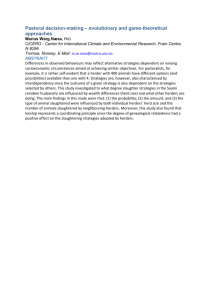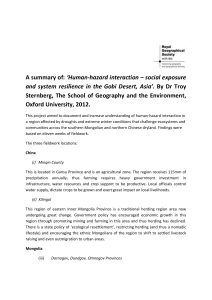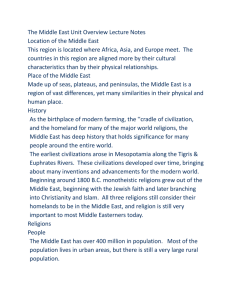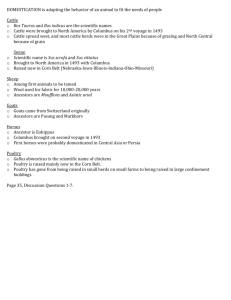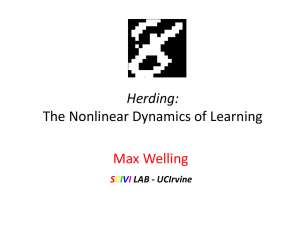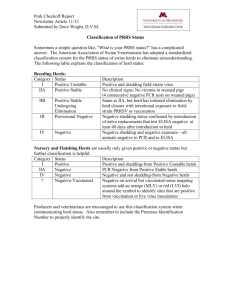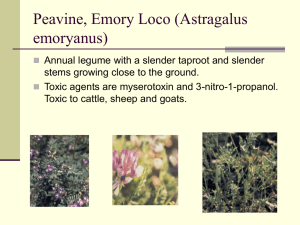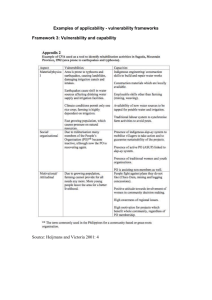Herding
advertisement
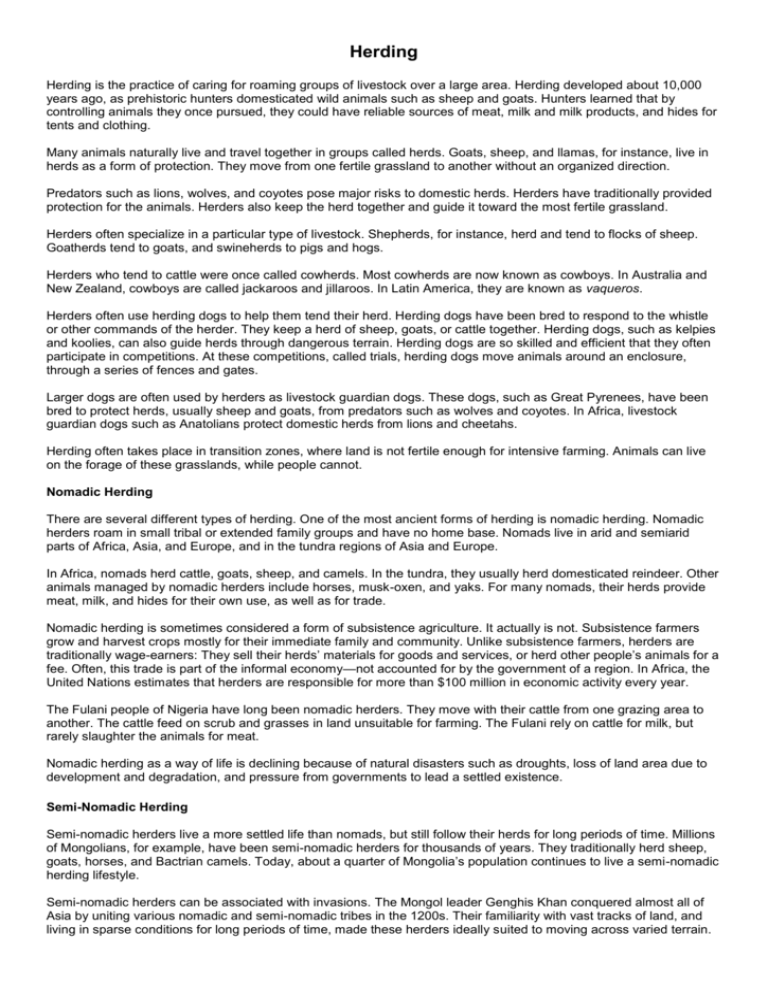
Herding Herding is the practice of caring for roaming groups of livestock over a large area. Herding developed about 10,000 years ago, as prehistoric hunters domesticated wild animals such as sheep and goats. Hunters learned that by controlling animals they once pursued, they could have reliable sources of meat, milk and milk products, and hides for tents and clothing. Many animals naturally live and travel together in groups called herds. Goats, sheep, and llamas, for instance, live in herds as a form of protection. They move from one fertile grassland to another without an organized direction. Predators such as lions, wolves, and coyotes pose major risks to domestic herds. Herders have traditionally provided protection for the animals. Herders also keep the herd together and guide it toward the most fertile grassland. Herders often specialize in a particular type of livestock. Shepherds, for instance, herd and tend to flocks of sheep. Goatherds tend to goats, and swineherds to pigs and hogs. Herders who tend to cattle were once called cowherds. Most cowherds are now known as cowboys. In Australia and New Zealand, cowboys are called jackaroos and jillaroos. In Latin America, they are known as vaqueros. Herders often use herding dogs to help them tend their herd. Herding dogs have been bred to respond to the whistle or other commands of the herder. They keep a herd of sheep, goats, or cattle together. Herding dogs, such as kelpies and koolies, can also guide herds through dangerous terrain. Herding dogs are so skilled and efficient that they often participate in competitions. At these competitions, called trials, herding dogs move animals around an enclosure, through a series of fences and gates. Larger dogs are often used by herders as livestock guardian dogs. These dogs, such as Great Pyrenees, have been bred to protect herds, usually sheep and goats, from predators such as wolves and coyotes. In Africa, livestock guardian dogs such as Anatolians protect domestic herds from lions and cheetahs. Herding often takes place in transition zones, where land is not fertile enough for intensive farming. Animals can live on the forage of these grasslands, while people cannot. Nomadic Herding There are several different types of herding. One of the most ancient forms of herding is nomadic herding. Nomadic herders roam in small tribal or extended family groups and have no home base. Nomads live in arid and semiarid parts of Africa, Asia, and Europe, and in the tundra regions of Asia and Europe. In Africa, nomads herd cattle, goats, sheep, and camels. In the tundra, they usually herd domesticated reindeer. Other animals managed by nomadic herders include horses, musk-oxen, and yaks. For many nomads, their herds provide meat, milk, and hides for their own use, as well as for trade. Nomadic herding is sometimes considered a form of subsistence agriculture. It actually is not. Subsistence farmers grow and harvest crops mostly for their immediate family and community. Unlike subsistence farmers, herders are traditionally wage-earners: They sell their herds’ materials for goods and services, or herd other people’s animals for a fee. Often, this trade is part of the informal economy—not accounted for by the government of a region. In Africa, the United Nations estimates that herders are responsible for more than $100 million in economic activity every year. The Fulani people of Nigeria have long been nomadic herders. They move with their cattle from one grazing area to another. The cattle feed on scrub and grasses in land unsuitable for farming. The Fulani rely on cattle for milk, but rarely slaughter the animals for meat. Nomadic herding as a way of life is declining because of natural disasters such as droughts, loss of land area due to development and degradation, and pressure from governments to lead a settled existence. Semi-Nomadic Herding Semi-nomadic herders live a more settled life than nomads, but still follow their herds for long periods of time. Millions of Mongolians, for example, have been semi-nomadic herders for thousands of years. They traditionally herd sheep, goats, horses, and Bactrian camels. Today, about a quarter of Mongolia’s population continues to live a semi-nomadic herding lifestyle. Semi-nomadic herders can be associated with invasions. The Mongol leader Genghis Khan conquered almost all of Asia by uniting various nomadic and semi-nomadic tribes in the 1200s. Their familiarity with vast tracks of land, and living in sparse conditions for long periods of time, made these herders ideally suited to moving across varied terrain. The Sami are semi-nomadic herders indigenous to the Arctic. They live throughout northern Norway, Sweden, Finland, and on the Kola Peninsula of Russia. For centuries, the Sami have herded reindeer as a principal means of livelihood, supplemented by fishing and trapping. Development has made it difficult for semi-nomadic herders to sustain their traditional way of life. State and national borders, for example, have divided traditional Sami land. Industries like timber and mining have reduced grazing land. Today, some laws exist to protect the Sami and their rights to use the land, but conflicts still exist. Transhumance Another type of herding is called transhumance. Transhumance herders follow a seasonal migration pattern, usually moving to cool highlands in the summer and warmer lowlands in the winter. Unlike nomads, these herders move between the same two locations, where they have permanent settlements. Transhumance has had an enormous impact on the landscape. In the European Alps, for instance, thousands of years of transhumance have transformed foothill forests into alpine pastures. Swiss and German herders traditionally led sheep, cattle, and pigs to pastures at elevations above 2,000 meters (6,562 feet). Transhumance in the Alps actually involved three herding grounds. The village floor, at the lowest elevation, was where livestock were kept sheltered during the cold and snowy winter months. Shepherds led herds to the middle pastures during the spring. During the summer and fall, shepherds led sheep and cattle to the high alpine pastures, while pigs stayed in the middle area. Transhumance is still widely practiced throughout agricultural communities in Switzerland, Germany, Austria, Italy, and Slovenia. The Kirghiz horsemen of Central Asia used to migrate between regions of eastern Afghanistan, western China, and southern Tajikistan with their herds of goats, yaks, and camels. They would spend their winters in the lower valleys of China or Tajikistan, moving to high mountain grasslands in the summer. When China restricted its borders to travelers, the Kirghiz transhumance herders lost the ability to summer in Chinese mountain valleys. While some Kirghiz have settled into sedentary lives in other regions, a small group still upholds their traditional lifestyle in the remote, austere Wakhan Corridor of Afghanistan. Ranches Most large-scale livestock herds today live on ranches. Ranching involves raising livestock on a single, large tract of land. Ranches are common in Australia and New Zealand, the western United States, Argentina, and Brazil. Ranchers don’t migrate the way nomadic or transhumance herders do. However, throughout most of the 1800s, ranchers in the United States set their cattle and sheep loose to roam the prairie as herds. Most of the grazing land was owned by the government, not individual ranchers. This was the socalled “open range.” Twice a year, cowboys would round up cattle for branding (in spring) and for gathering for sale (in autumn). Round-ups are still a part of ranching culture, but livestock now roam on private land. Herding and Land Use Herders maintain complex maps of the area where their herds graze. These maps include seasonal weather patterns; partnerships or conflicts with other herders, ranchers, or landowners; and soil quality. Herders can be excellent resources for data about the agricultural fertility of an area. A herder’s vast knowledge is threatened by the pressure to conform to modern society. Permanent residence allows members of a community to have access to education and health care facilities. It also affords members a greater choice in their professional and personal lives. However, the complex social structure of herding communities is lost as they are absorbed into mainstream culture. Unique language and customs become outdated and not useful in settled urban or suburban life. The Bedouin people of the Arabian Peninsula and the Middle East, for example, are almost entirely semi-nomadic and settled. Prior to the 20th century, Bedouins were mostly nomads, herding sheep and goats. A series of droughts in the 1960s throughout Western Asia limited fertile areas. Oil production in Egypt and Saudi Arabia further limited land available for grazing. More importantly, however, Bedouins sought a better standard of living. Schools, health-care facilities, law enforcement, and social opportunities are usually greater in settled areas than through herding lifestyles.
